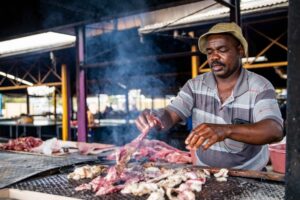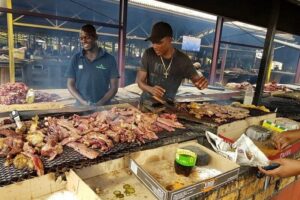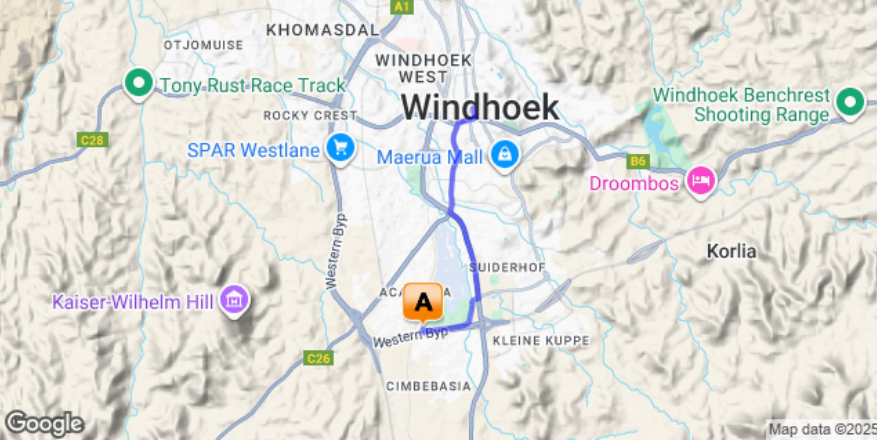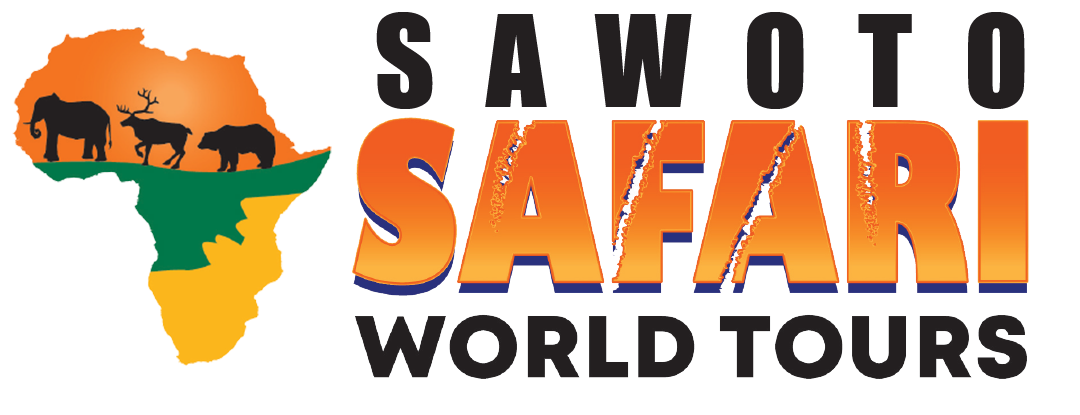Zögern Sie nicht, uns anzurufen. Unser Team ist für Sie da.
+264 81 8211 521
info@safariworldtours.com
Embark on this 3-hour city tour, offers a compelling journey through Windhoek’s past and present.
Clients begin in the city center, visiting major landmarks like Christ Church, the Parliament
Building (Tintenpalast), the Parliament Gardens, and the Old Fort. These sites provide insight into
Namibia’s colonial roots, its governance, and its path to independence.Then you transition into Katutura township, an area home to over two-thirds of Windhoek’s
population. The drive and guided walk through Katutura expose contrast between formal city areas
and informal township life. You’ll get to learn how colonial and apartheid policies shaped spatial
geography, how people in Katutura live, work, and sustain culture. There are market visits, local
food, crafts, stories, and a chance to interact with residents. The tour ends with reflection, allowing
questions and consolidation of the history and impressions.
Windhoek, affectionately known as “Windy Corner,” is situated atop a natural hot spring and boasts a rich and layered history. Remarkably, it has been founded twice: first in 1840 by Jonker Afrikaner, a warlord and leader of the Orlam people, who established a settlement and constructed a stone church in what is now Klein Windhoek. However, due to ongoing conflicts, both the settlement and the church were destroyed over the ensuing decades. The city was re-established in 1890 by Major Curt von François of the Imperial German Army, who founded it in the name of Germany and Kaiser Wilhelm II
Our journey today will lead us through the historic landmarks of “Imperial European Windhoek” and into the vibrant heart of “African Windhoek” in the suburb of Katutura.
We begin with Windhoek’s most iconic landmark, Christuskirche (Christ Church). This Evangelical Lutheran church stands proudly on its own traffic island, with a 42-meter spire reaching towards the heavens. Constructed between 1907 and 1910, it is a remarkable blend of Neo-Romanesque, Gothic Revival, and Art Nouveau styles. The church’s walls are built from local quartz sandstone quarried near Avis Dam, and the altar features Carrara marble imported from Italy. Inside, visitors can admire stained glass windows donated by German Emperor Wilhelm II and three bronze bells inscribed with “Glory to God in the Highest,” “Peace on Earth,” and “Goodwill to All Men.” Declared a national monument in 1974, Christuskirche remains an active place of worship and a testament to Namibia’s rich architectural heritage
The Christuskirche is designed in the shape of a Latin cross, accommodating up to 400 worshippers. Constructed from local quartz sandstone sourced near Avis Dam, the church’s main entrance is framed by six Carrara marble pillars imported from Italy. The foundation stone was laid in 1907, and the church was officially consecrated on October 16, 1910. Inside, visitors can admire three bronze bells, each inscribed with “Glory to God in the Highest,” “Peace on Earth,” and “Goodwill to All Men.” The church also features three stained-glass windows, gifts from German Emperor Kaiser Wilhelm II, which were recently restored after being installed incorrectly for decades.
Just down the road from Christuskirche stands another significant landmark and declared National Monument: the Alte Feste, or Old Fortress. As Windhoek’s oldest surviving building, it was designed by Captain Curt von François to serve as the headquarters for the German Schutztruppe (colonial military force) during the German colonization of South West Africa. Construction began in 1890, and after several redesigns, the final version was completed in 1915, taking 25 years to build, a significant investment of time, effort, and resources into a fortress that ultimately never saw military action. The structure features an inner courtyard, barracks for soldiers, and four impressive corner towers. Following Germany’s defeat in World War I, South African Union troops occupied Windhoek in 1915, and the Alte Feste became their military headquarters. In 1935, it was repurposed as a hostel for Windhoek High School students.
The building was declared a National Monument in 1957 and later housed the National Museum of Namibia until it closed for renovations in 2014. Plans are underway to revitalize the Alte Feste into a Center for Arts, Crafts, and Heritage, as well as a National Museum of Genocide and Colonial History, aiming to transform this historic site into a vibrant cultural hub.
The fort was eventually put to more peaceful usage. In 1935 it was converted into a hostel for students attending the adjacent Windhoek High School and it was for some time the home of the Namibian national museum From here, again it is only a short distance to our next place of interest, the Namibian parliament building, which is locally known as Ink Palace, (Tintenpalast). Ink, as in real ink used for writing, and the name gives reference to the amount of ink that is used on all the official documents produced by parliament.
The building was built by Imperial Germany in 1913 to house the colonial administration and was controversial even then, as it was constructed using the forced labour of the Herero and Nama people.
These were the survivors of the defeated Namibian tribes in the war that proceeded the colonisation of Namibia by Germany between 1904 and 1908. After Namibian independence (from South Africa), in 1990, Tintenpalast became the home of the Namibian Parliament, the Namibian National Council, and the Namibian National Assembly. The building is Neoclassical and is built from local and regional materials. Tintenpalast is also home to a small but beautiful area of gardens. Open to the public, well laid out and shady, the gardens are popular with locals and visitors alike and are well worth the visit. Here in the gardens, you will also find three bronze statues of high historical interest.
Chief Hosea Katjikururume Komombumbi Kutako, (1870 – 18 July 1970). Known as Namibia’s first truly nationalist politician and a man who strove for the greater good not only for himself but for all. He experienced the transition of his country from independence to colonisation and he was a leader in the struggle to regain freedom and self-determination of all Namibians.
Hendrik Samuel Witbooi, (1 June 1906 – 29 July 1978). Recognised as a hero of the Namibian independence movement and a tireless campaigner against the South African administration of Namibia. (The then League of Nations had ceded Namibia to South Africa at the end of World War 11). He was instrumental in petitioning the United Nations and succeeded in forcing the UN to reject requests by the South African government to make Namibia a permanent province of South Africa. Theophilus Hamutumbangela, (6 February 1917 – 28 November 1990). A leading Namibian antiapartheid activist, priest, and persistent international promoter of Namibian independence. Hamutumbangela spoke out against the racism and injustices of the apartheid regime.
It is alleged that he was poisoned by the South African authorities, although not a fatal incident, the poison apparently paralysed his nervous system, and he was left physically and mentally handicapped.
From here we drive out of the main city center with it’s impressive buildings and European history and head to Katutura, Windhoek’s largest suburb. During the dark days of apartheid so called ‘’townships’’ were attached to every town in Namibia. All non-whites were forced to live in designated township areas that separated them by race, language, and culture. Today the vast majority of Namibians still live in these locations and in Windhoek Katutura has evolved into an eclectic experience of African culture and lifestyle. First stop is the so called ‘’Single Quarters’’. In years now thankfully gone by, this was a depressing area of Katutura. Barrack like cells and dormitories were located here and were used to house men who had come from the regions to work in Windhoek.


Their families were left behind; only men were allowed to live in this squalid area. That was the past, the hated accommodation has gone, and so has the name; the area is now officially called Oshetu Community, an Oshiwambo expression meaning ‘this is our community,’ and the area now houses one of the most vibrant markets in Namibia, being particularly famous for Kapana.
Kapana could perhaps best be described as the unofficial national dish of Namibia. Strips of fatty beef are quickly cooked over a very hot barbecue (braai in local terminology), and eaten piping hot with the fat running down your fingers. Plain or spicy meat is available, and many stalls have their own recipe spice or dipping sauce for you to try.
There are other delicious foods available at Oshetu and we have the chance to try several other traditional Namibian dishes to go with the Kapana. From Oshetu we head through the colourful and busy streets to the community projects centre at Penduka.
Penduka translates as ‘’Wake Up’’ and this is the perfect name, in their own words the Penduka people describe their project as ‘’a social enterprise and training centre for local, less privileged women in Namibia. We have the opportunity here to interact and engage with the Penduka ladies. We can learn about the different and diverse projects that they are running and we have time to browse the many and varied items for sale in their shop.
From Penduka we head back to the Windhoek City Centre and you will be dropped off at your accommodation anywhere within the Windhoek City limits.

Bitte lesen Sie unsere Allgemeinen Geschäftsbedingungen, indem Sie auf den Link klicken: https://safariworldtours.com/terms-conditions
